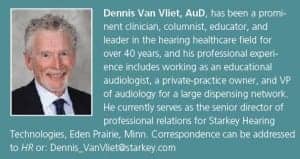Final Word | June 2017 Hearing Review
Fifty-one years ago, in June of 1966, I joined the US Navy to fulfill my obligation for service to the United States. I was 20 years old that year, and although I had traveled to Europe and the Middle East, I was very naïve about world events, especially those in Southeast Asia. I joined not because I understood or agreed with the conflict in Vietnam, but because I faced an obligation; a duty to serve the country. As I worked my way through boot camp and training in aviation electronics, I found a way to appreciate the tasks that were required of me, and learned that the best reward is a job well done. In the complex society that is the military, especially that unique society of an enlisted sailor, I could not expect any other reward. I accepted that, and focused my interest on doing a good job of repairing the complex communication, electronic countermeasure, and weapons delivery systems on the Douglas A4 aircraft my squadron flew.
Those of us who have chosen to earn a living serving those who have difficulty hearing also have an obligation: a duty to do what is right for the patient. In that endeavor, we face conflicts. My friends who are business people tell me we have a duty to do what is right for the business. Business people also recognize that they have to take care of their customers, or word will get around and their business may not attract more customers. They adopt practices that are business-based with the goal of a successful business. Our conflicts come from the fact that we have ethical responsibilities that may put the patients’ needs ahead of us or the business. Decisions to resolve these conflicts must be carefully worked out. I doubt that reasonable consumers would expect that we give away products because it is best for them. Yet, our most common service model encourages us to provide service at no additional cost after a single initial payment. The advantage of the common model is that the business is funded up front with a promise of follow-up visits at “no cost.” Unfortunately, the no-cost provision may build an expectation that the service isn’t worth much, and the device is the most important part of the process.
Low-cost hearing aids by mail order, or recently online, have a long history with a record of enough success to keep those vendors alive. The mail-order or online sales model isn’t for all consumers, but enough consumers respond to keep those businesses alive. Historically, online and mail-order sales haven’t been much of a problem for traditional product and service providers.
The recent focus on over-the-counter (OTC) hearing aids is different because it has put the discussion and our traditional model in front of regulatory agencies and consumers in a free-for-all discussion format. The dustup is a classic example of a loud and emotional exchange of ignorance. The truth is that currently there isn’t enough evidence to know how well direct-to-consumer will work across the population that we serve. However, there is work in progress to investigate how typical consumers may fare when given a product designed to be self-fitting. At the 2017 American Auditory Society meeting in Scottsdale, Ariz, Elizabeth Convery, an audiologist from the National Acoustic Laboratories (NAL) in Australia reported preliminary results from a study of the experiences of 60 adults with self-fitting hearing aids.1 The outcomes overall were that, with good instruction materials, some subjects could successfully fit themselves; some correctly identified problems, but needed help with the fitting; and some could not successfully fit themselves. These preliminary data suggest, not surprisingly, that there is a spectrum of capabilities in the population, that there will continue to be consumers who need our help, and it follows that there will be those who may want products with features and cosmetics not offered in OTC devices.
These are the consumers who we will see in the coming years. Those who need our assistance in the selection and fitting of products that will help with their communicative difficulties. As we do today, we will have an obligation to do what is right for these consumers. It will serve them and our businesses well if we can create service packages that not only help guide and serve the consumers, but that promote an appreciation for the skills and knowledge necessary to do what is right for them.
The Final Word? We have an obligation and a duty to serve the consumers we see in a competent and fair manner. We all need to provide for our families and make a living, but our best rewards may often come from the satisfaction of a job well done. For us, the patients, and our profession, the best thing we can strive for is to build value for the service we provide so that compensation is recognized as payment for deeds, more than objects. When our service is recognized and valued, we should have no trouble making an honest, respectable living.
Reference
-
Convery E, Keidser G. Left to their own devices? What the evidence tells us about self-fitting hearing aids. Paper presented at: Special Session: Patient-Focused Emerging Technologies. American Auditory Society Scientific and Technology Meeting; March 2-4, 2017; Scottsdale, Ariz.
Original citation for this article: Van Vliet D. Serving Your Patients and OTC Devices. Hearing Review. 2017;24(6):50.







